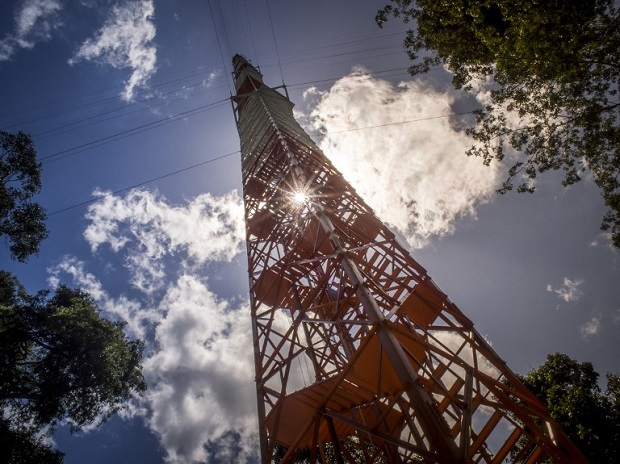Brazil builds climate tower in pristine Amazon jungle

The 325-meter-high Amazon Tall Tower Observatory (ATTO), a giant observation tower lifted in the heart of the Amazon to monitor climate change and its impact on the region’s sensitive ecosystem, raises above the jungle in the Scientific Station of Uatuma, in Sao Sebastiao do Uatuma, a municipality located in the Brazilian state of Amazonas, about 170 km from Manaus, on its inauguration day, August 22, 2015. The ATTO is a project of Brazil’s National Institute of Amazonian Research and Germany’s Max Planck Institute that will gather data on heat, water, carbon gas, winds, cloud formation, carbon absorption and weather patterns to monitor relationships between the jungle and the atmosphere. AFP PHOTO
SAO SEBASTIAO DO UATUMA, Brazil—Deep in the pristine Amazon jungle, Brazil’s newest skyscraper has a mission unlike any other: to save the world.
The white and orange metal frame called Amazon Tall Tower Observatory, or ATTO, is a bold new tool in the push to understand climate change and the vital role of rainforests.
At 325 meters (1,066 feet), the ATTO is a meter (3.3 ft) higher than the Eiffel Tower and a good bit taller than London’s loftiest building, the Shard.
But instead of the typical city din of honking horns and engines, the loudest noise around the skinny structure is the chatter of cicadas and tropical birds.
Built in the Uatuma nature reserve, 350 kilometers (217 miles) from the city of Manaus and reachable only after hours of rough roads and a boat ride, the ATTO is seriously remote—and for the climate scientists that’s the point.
“Being far from towns and man’s influence ensures we can collect relatively pure data,” said Meinrat Andrae, director of the Max Planck Institute of Chemistry, which is partnering with Brazilian research agency Inpa on the German-Brazilian funded project.
The Amazon is seen as a big piece of the global warming puzzle, since trees are a key weapon in safely capturing destructive carbon gasses. And at 3,000 km wide, the Amazon is the greatest of all rainforests, known to many as the lungs of the world.
“Thanks to this tower we’ll be able to better understand the role of the Amazon, its effect on the local climate and also on the global climate,” said Antonio Ocimar Manzi, one of the Brazilian scientists.
Fresh air
Rising far above even the mightiest Amazonian trees, the tower is good place to swap the suffocating jungle heat for fresh air, as long as you don’t mind heights.
Wearing a safety harness is compulsory as journalists are led 150 m up.
The observatory is the tallest of its kind, beating a similar structure known as ZOTTO in Russia’s Siberia region. And ATTO is in a geographical area that has come to symbolize the whole world’s struggle.
Greenhouse gas emissions have rocketed since the second half of the 20th century, dangerously warming the globe, according to most scientists.
Healthy forests are one of the best ways to absorb the gasses. But deforestation for lumber or farming, a major issue in the Amazon, is a major cause of the gasses, since the stored up CO2 is released from the dead tree into the atmosphere.
A worst case scenario predicted by some models foresees a vicious circle where global warming and drought kill so much of the Amazon that drought increases and the remains of the jungle became unsustainable, leading to even worse global warming.
“The Amazon region is of global significance: it produces half of the word’s oxygen, impacts the water cycle through evaporation and stabilizes the climate,” the Max Planck Institute for Chemistry said.
The tower, which cost about $7.4 million and consists of 15,000 pieces, was inaugurated last week, but won’t collect data until later in the year.
The goal is to have ATTO, which links up with two smaller towers of 50 and 80 m, running for 20 to 30 years to allow a long-term study of the effects of carbon gasses. Its great height will be a big improvement on previous methods.
“The 325 meters height allows the monitoring of an unprecedented atmospheric area of nearly 1,000 square kilometers,” the Brazilian government says.
“This will fill holes in the monitoring and collection of data done by satellites and other instruments.”














